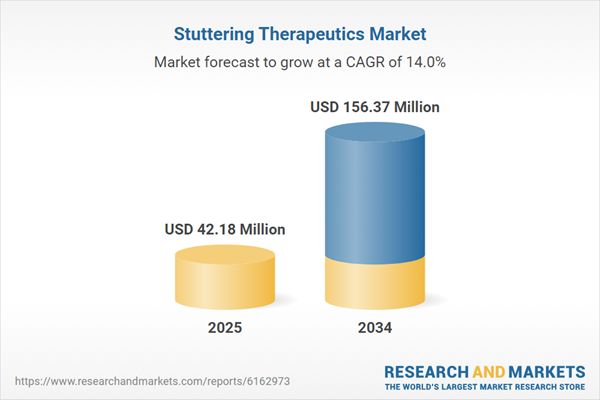Stuttering Therapeutics: Introduction
Childhood onset fluency order or stuttering is a speech disorder that disrupts the rate and rhythm of fluency. It is characterized by the repetition, prolongations, and broken words. Motor movements like blinking, tremors, jerks or breathing movements may persist in rare cases.Developmental stuttering is the most common type of stuttering, which is mostly observed in young kids while learning speech and language skills. It occurs when the speech and language abilities is not compatible with its verbal requirements. Neurogenic stuttering is another category and it occur post head trauma, brain injury or a stroke. Speech therapy, drug therapy, self-help groups and electronic devices are commonly used to treat stuttering.
Global Stuttering Therapeutics Market Analysis
The United States accounts for the highest number of stuttering cases, ranging from 1.15% to 2.52%. Europe falls in the range between 0.58% to 2.2%. Australia and Africa stand at 0.33%-1.8% and 1.03% respectively . In Asia, countries like Iran, Iraq, Pakistan, Nepal, and few parts of India observe stuttering cases quite commonly when compared to others.During the historical period, stuttering therapeutics have been in a high demand in the North American region, with high prevalence of cases. However, it is anticipated that over the forecast period, stuttering therapeutics market share would rise in both the European and Asia Pacific regions due to the growing awareness and technological advancements around stuttering treatments.
Stuttering prevalence varies due to multiple factors, including gender, age, number of languages known, and financial status. Research indicates that the average male to female stuttering ratio is around 4:1. Stuttering in bilinguals lies at 2.8%, whereas it is comparatively lower in monolinguals (1.8%). Researchers are getting more inclusive and innovative with different type of therapeutics to cater to all the components elevating the stuttering cases.
The global market for stuttering therapeutics has witnessed significant growth over the past few yeats. Speech therapy is the most successful category of stuttering treatments. Various behavioural therapies like cognitive behavioural therapy (CBT) and neuromodulation are also beneficial. In the pharmacologic treatment, dopamine blocking medications have confirmed efficacy against stuttering. D2 dopamine blockers are effective in decreasing the symptoms of stuttering. Moreover, they have a lower risk of motor system side effects. Medications with calcium channel blockers can also help. With further research and technological advancements, we can observe efficient and economical treatments for stuttering.
Global Stuttering Therapeutics Market Segmentation
“Stuttering Therapeutics Market Report and Forecast 2025-2034” offers a detailed analysis of the market based on the following segments:Market Breakup by Treatment
- Speech Therapy
- Stuttering Devices
- Cognitive Behavioural Therapy
- Parent Child Interaction
- Drug Therapy
Market Breakup by Type
- Developmental Stuttering
- Neurogenic Stuttering
Market Breakup by End User
- Hospitals
- Specialty Clinics
- Homecare
- Others
Market Breakup by Region
- North America
- Europe
- Asia Pacific
- Latin America
- Middle East and Africa
Global Stuttering Therapeutics Market Overview
Earlier, there were no FDA approved medications to treat stuttering, but that has changed over the years. Ecopipam is an investigational drug developed by Emalex Biosciences Inc. It is designed to treat stuttering symptoms and has shown fair endurance in the clinical trials. Ecopipam works by blocking the action of Dopamine at D1 receptor. The super-sensitivity of this receptor can be linked to the repetitive and compulsive behaviours associated with stuttering as well as Tourette syndrome.As we are living in a digital world, development of speech therapy apps has led to a gradual increase in the stuttering therapeutics market growth. Speech therapy applications are designed for all age groups, ranging from toddlers to adults. Children can engage with entertaining voice playbacks and interactive games to improve their speech. Adults can use the apps to develop conversational abilities or to get back on track after a stroke. Stamurai, Stamma, Splingo, Articulation Station are some examples of the applications.
Electronic devices are the newest addition to the stuttering therapeutics global market. An electronic device called SpeechEasy reduces stuttering by manipulating auditory feedback. It works via time delays and frequency shifts. A group of people who stutter were examined on several parameters like device settings, ear-placements, speaking tasks, and cognitive variables. With this device, a significant reduction in stuttering was observed. Therefore, we can assume that with the development of such electronic devices, the therapeutics market for stuttering will observe notable progression in the coming years.
Global Stuttering Therapeutics Market: Competitor Landscape
The key features of the market report include patent analysis, grants analysis, clinical trials analysis, funding and investment analysis, partnerships, and collaborations analysis by the leading key players. The major companies in the market are as follows:- Emalex Biosciences Inc.
- Auspex Pharmaceuticals (Teva Pharmaceutical Industries Ltd.)
- GSK plc.
- Johnson & Johnson Services, Inc.
- Merck & Co., Inc.
- Pfizer Inc.
- Siemens Healthcare GmbH
- Novartis AG
- AstraZeneca
- AbbVie Inc.
This product will be delivered within 3-5 business days.
Table of Contents
Companies Mentioned
- Emalex Biosciences Inc.
- Auspex Pharmaceuticals (Teva Pharmaceutical Industries Ltd.)
- GSK plc.
- Johnson & Johnson Services, Inc.
- Merck & Co., Inc.
- Pfizer Inc.
- Siemens Healthcare GmbH
- Novartis AG
- AstraZeneca
- AbbVie Inc.
Table Information
| Report Attribute | Details |
|---|---|
| No. of Pages | 350 |
| Published | July 2025 |
| Forecast Period | 2025 - 2034 |
| Estimated Market Value ( USD | $ 42.18 Million |
| Forecasted Market Value ( USD | $ 156.37 Million |
| Compound Annual Growth Rate | 14.0% |
| Regions Covered | Global |
| No. of Companies Mentioned | 10 |









